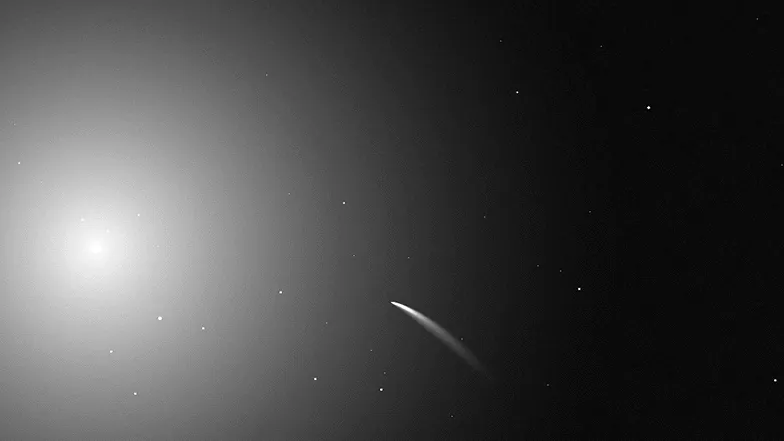
Brace Yourselves! The Once-in-160,000-Years Comet G3 ATLAS is Set to Dazzle in the Sky This Week!
2025-01-09
Author: Sarah
Get ready for a celestial spectacle! The much-anticipated Comet G3 ATLAS (C/2024), the brightest comet to grace our skies in nearly two decades, is about to reach its peak brilliance. This cosmic phenomenon is expected to shine as bright as Venus, making it a must-see event for skywatchers around the world.
What is Comet G3 ATLAS?
Comet G3 ATLAS was first detected on April 5, 2023, by the Asteroid Terrestrial-impact Last Alert System (ATLAS) using a 0.5-meter telescope in Chile. Initially, it was a faint sight, nearly 407 million miles from Earth, with a magnitude of +19—about 158,000 times dimmer than the faintest star visible without assistance!
This comet is particularly fascinating because it is on a very long orbit, estimated to take about 160,000 years to complete. Scientists initially thought it was a newcomer from the Oort Cloud, a region teeming with icy bodies in the far reaches of our solar system. However, further observations revealed that G3 ATLAS had made at least one past close pass by the sun, raising hopes for a vivid display after this encounter.
Who Can See It?
Unfortunately, while the comet has been drawing the attention of southern hemisphere observers for months, its visibility for northern skywatchers has been challenging. But fear not, as G3 ATLAS is making its way toward the northern horizons. As it moves closer to the sun in the coming days, the chances to spot this miraculous sight will increase!
Sky observers in the Northern Hemisphere should keep an eye on a brief window of opportunity from January 12 to 14. On January 12, the comet will rise about 35 minutes before dawn, appearing just above the horizon. Fast forward to January 14, and it will set shortly after sunset, providing another chance to catch a glimpse.
Will It Survive Its Close Encounter?
A recent outburst detected on January 2, 2025, already hinted at a significant increase in brightness, which has raised concerns among astronomers regarding the comet's integrity. Noted comet observer John Bortle expressed uncertainties about the comet's stability, suggesting that this unusual brightness might indicate possible disintegration. However, other experts like Nick James noted that the comet continues to shine brighter, indicating that it may have survived this burst after all.
How Bright Could G3 ATLAS Get?
Predictions on the comet's brightness vary widely, with estimates suggesting it may reach between -3 and -6 on the magnitude scale (higher numbers mean brighter and more visible). On the brightest scale, G3 ATLAS could outshine celestial giants like Jupiter and Venus! Astronomers are particularly excited about a phenomenon called forward scattering, which could enhance the comet's brightness if positioned correctly relative to the sun.
Tips to Spot G3 ATLAS
1. **Get Prepared**: Find a location with a clear view of the east-southeast and west-southwest horizons, where you can observe the comet's rise and set.
2. **Timing is Key**: On the mornings of January 12 and 13, look for the comet as it rises before the sun. The evening of January 14 also offers potential for spotting it as it sets.
3. **Use Binoculars**: While it may appear as a bright star, a good pair of binoculars, around 7x50 or larger, could enhance your chances of seeing it clearly.
4. **Safety First**: If you want to attempt to see it during daylight, remember that looking towards the sun is incredibly dangerous. Observing through a telescope or binoculars while the comet is near the sun is not advisable.
The Ultimate Viewing Experience
For those who can’t catch a glimpse of the comet in person, don’t miss the opportunity to view live footage through NASA’s Solar and Heliospheric Observatory (SOHO) mission. The stunning views captured will provide a breathtaking look at this extraordinary comet as it passes close to the sun.
Get ready, because this is an astronomical event you won’t want to miss—mark your calendars for January 12 to 14, and prepare for a cosmic treat that could light up your night sky! Will G3 ATLAS become the brightest comet of our time? Stay tuned—this thrilling interstellar journey is just beginning!



 Brasil (PT)
Brasil (PT)
 Canada (EN)
Canada (EN)
 Chile (ES)
Chile (ES)
 Česko (CS)
Česko (CS)
 대한민국 (KO)
대한민국 (KO)
 España (ES)
España (ES)
 France (FR)
France (FR)
 Hong Kong (EN)
Hong Kong (EN)
 Italia (IT)
Italia (IT)
 日本 (JA)
日本 (JA)
 Magyarország (HU)
Magyarország (HU)
 Norge (NO)
Norge (NO)
 Polska (PL)
Polska (PL)
 Schweiz (DE)
Schweiz (DE)
 Singapore (EN)
Singapore (EN)
 Sverige (SV)
Sverige (SV)
 Suomi (FI)
Suomi (FI)
 Türkiye (TR)
Türkiye (TR)
 الإمارات العربية المتحدة (AR)
الإمارات العربية المتحدة (AR)